Victorian Dancing Etiquette
Victorian Dancing Etiquette
.
The etiquette governing balls and country dances in the American Victorian Era seems archaic to today’s reader.
Every rule demanded of society seemed to have one thing in mind–to prevent the moral decay of young women and young men.
.
Wow–how times have changed!
.
.

.
Learn to Dance!
.
Non-Dancers Should Not Accept Invitations
.
It is bad manners to go to a ball unless one is accomplished in the art of dancing. To do so it to take the place of one who may be more expert and therefore in greater request. Consequently, every man who wishes to be a success in society must learn to dance.
.
~ Manners for Men by Mrs. Humphry, 1897
.

Image: We Heart It
.
DANCE LESSONS
.
To all gentlemen, I would say; Learn to dance. You will find it one of the best plans for correcting bashfulness. (1875; quoted from Gentleman’s Book of Etiquette and Manual of Politeness by Cecil B. Hartley)
.
.
What to Wear to the Ball: White Gloves
.
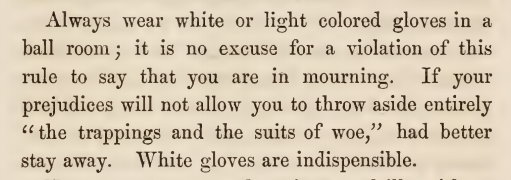
White Gloves are indispensable ball room etiquette, from The Amateur’s Preceptor on Dancing and Etiquette by Prof. D. L. Carpenter of Philadelphia, 1854.
.
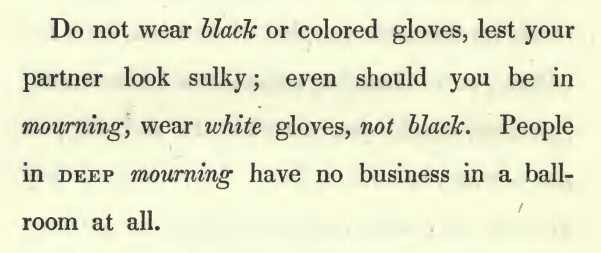
Black gloves forbidden in the ball room. From Hints on Etiquette and The Usages of Society with a Glance at Bad Habits (Adapted to American Society) by Charles Wm. Day, 1844.
.

.
Dangers of Frequent Personal Contact in Dancing
.
GIRLS WHO TAKE THE LEAD
.
Girls who are addicted to the dance are accustomed to frequent personal contact with men. These girls are many times inclined to bestow favors. They sometimes invite familiarities. (1916; quoted from Eugenics by T.W. Shannon) [sic]
.
.
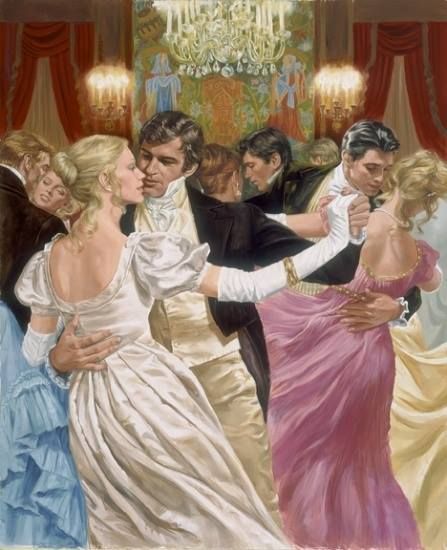
Image: Pinterest.
.

.
Properly Asking a Lady to Dance
.

The Amateur’s Preceptor on Dancing and Etiquette by Prof. D L. Carpenter, of Philadelphia, 1854.
.
HOW TO ASK A LADY TO DANCE
.
In inviting a lady to dance with you, the words, “Will you honor me with your hand for a quadrille?” or, “Shall I have the honor of dancing this set with you?” are more used now than “Shall I have the pleasure?” or, “Will you give me the pleasure of dancing with you?” (1881; quoted from Decorum: A Practical Treatise on Etiquette and Dress of the Best American by John A. Ruth)
.
.
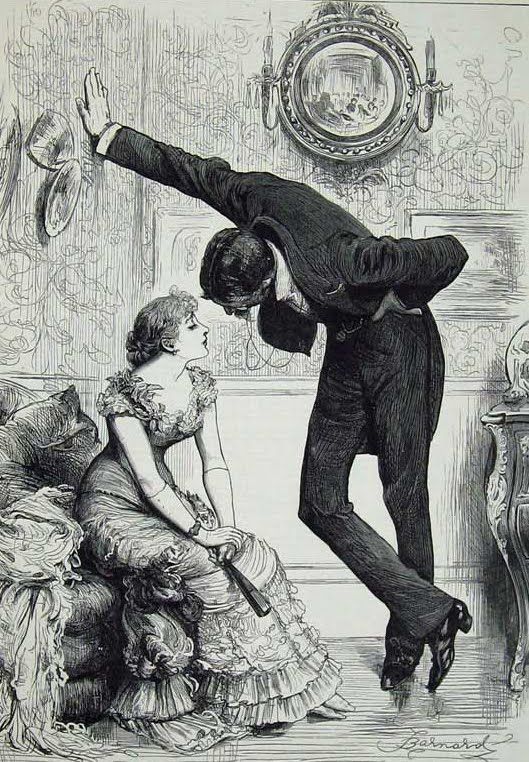
Image: Pinterest.
.
The Dance Bow
.
THE DANCE BOW
.
A gentleman should always make a bow to a lady when asking her to dance, and both of them should bow and say “Thank you” when the dance is over. (1887; quoted from Social Customs by Florence Howe Hall)
.
.
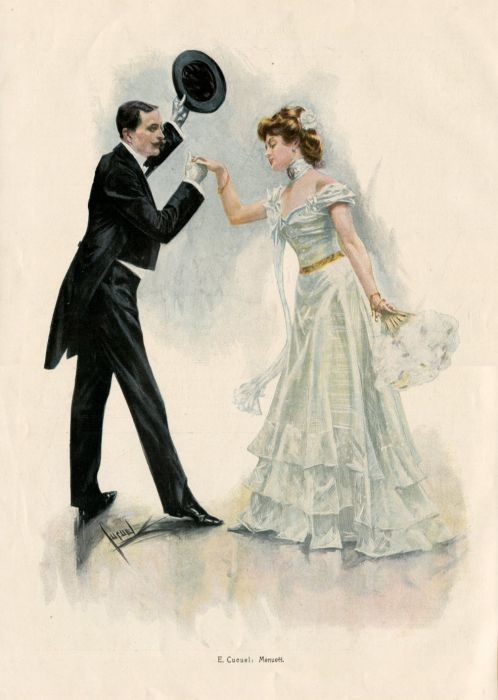
Image: Pinterest
.
THE CURTSEY VS THE BOW
.
Formerly it was the habit for the ladies to curtsey on being introduced, but this has been changed into the more easy and graceful custom of bowing. (1868; quoted from Manners by Sarah Josepha Buell Hale) [sic]
.
.
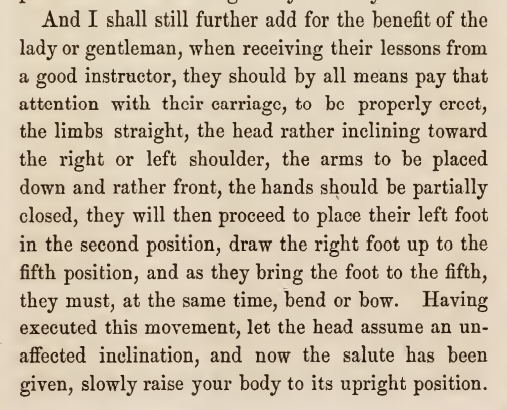
How men should properly bow, from The Amateur’s Preceptor on Dancing and Etiquette by Prof. D. L. Carpenter of Philadelphia, 1854.
.
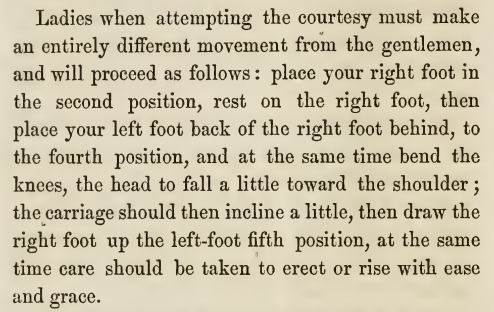
Ladies bow properly, with a dancer’s grace. From The Amateur’s Preceptor on Dancing and Etiquette by Prof. D. L. Carpenter of Philadelphia, 1854.
.

.
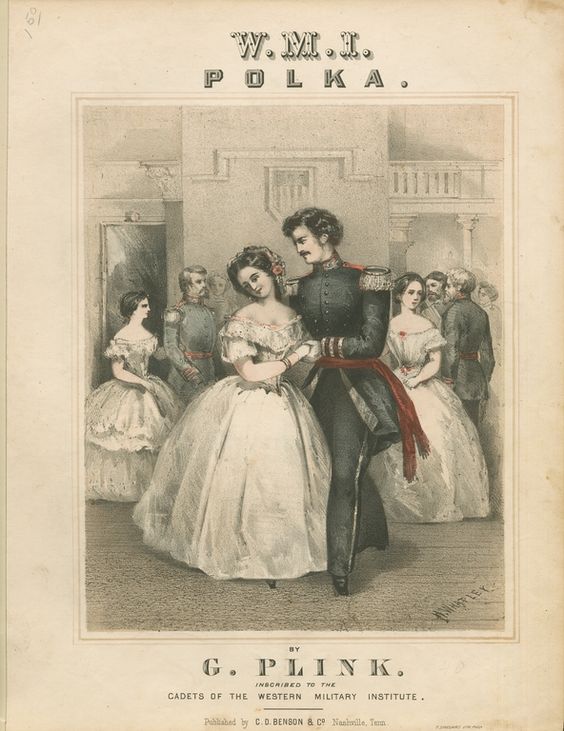
Image: Pinterest.
.
REFUSING TO DANCE
.
A lady cannot refuse the invitation of a gentleman to dance, unless she has already accepted that of another, for she would be guilty of an incivility which might occasion trouble; she would, moreover, seem to show contempt for him whom she refused, and would expose herself to receive in secret an ill compliment from the mistress of the house. (1881; quoted from Decorum: A Practical Treatise on Etiquette and Dress of the Best American by John A. Ruth)
.
.
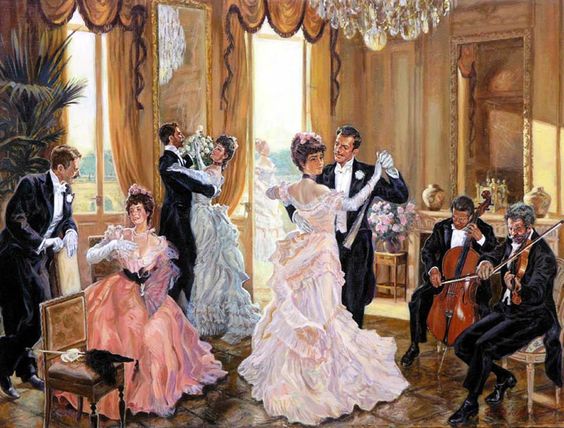
Image: Pinterest.
.

.
GROSS FAMILIARITY
.
You should smile when you take a lady’s hand. To squeeze it, on the other hand, is a gross familiarity, for which you would deserve to be kicked out of the room. (1875; quoted from Gentleman’s Book of Etiquette and Manual of Politeness by Cecil B. Hartley)
.
.
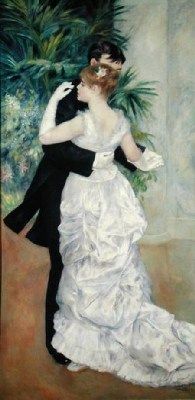
Image: Pinterest.
.

.
Dancing Together
.
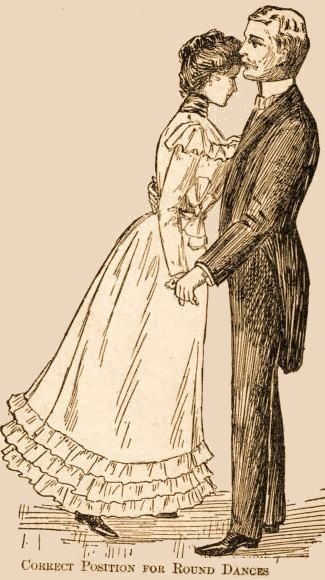
Image: Pinterest.
.
EASY DOES IT, GENTLEMEN!
.
Dance quietly; do not kick and caper about, nor sway your body to and fro; dance only from the hips downward; and lead the lady as lightly as you would tread a measure with a spirit of gossamer. (1843; quoted from Hints on Etiquette and the Usages of Society by Charles William Day)
.
.
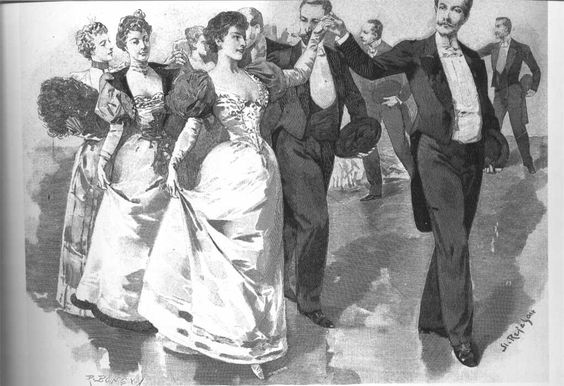
A Good Party Starts With A Polonaise! Image: Pinterest
.
ATTRACTING ATTENTION
.
Dance with grace and modesty; neither affect to make a parade of your knowledge; refrain from great leaps and ridiculous jumps which would attract the attention of all towards you. (1841; quoted from Gentleman and Lady’s Book of Politeness by Elisabeth Celnart)
.
BECOMING NOTICED
.
A young lady should not dance with the same partner more than twice unless she desires to be noticed. (1892; quoted from Our Manners and Social Customs by Daphne Dale)
.
.
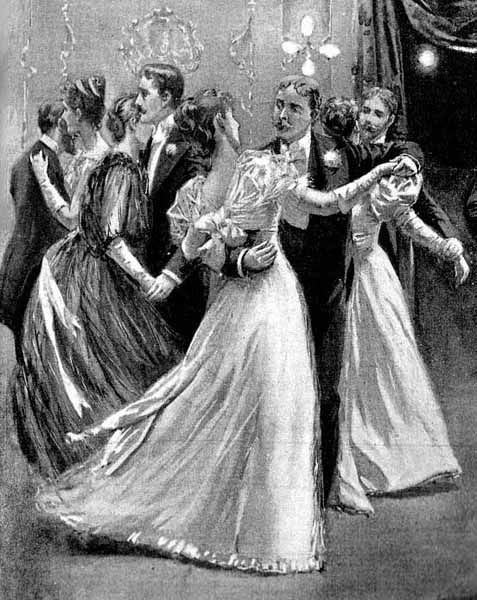
Image: Pinterest.
.
DO NOT DRAG HER
.
Lead the lady through the quadrille; do not drag her, nor clasp her hand as if were made of wood lest she not unjustly think you a boor. (1843; quoted from Hints on Etiquette and the Usages of Society by Charles William Day)
.
.
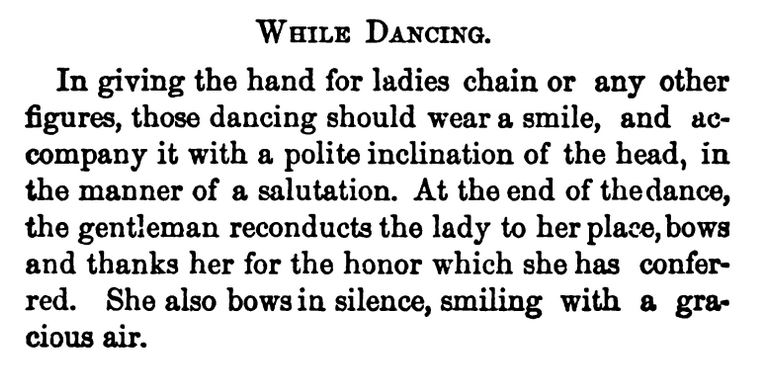
Ruth, John A.. Decorum: a Practical Treatise On Etiquette And Dress of the Best American Society. New York, [etc.]: Union Publishing House, 1881.
.
EASY DOES IT
.
A lady–a beautiful word!–is a delicate creature, one who should be reverenced and delicately treated. It is, therefore, unpardonable to rush around in a quadrille, to catch hold of a lady’s hand as if were a door-handle, or to drag her furiously across the room. (1875; quoted from Gentleman’s Book of Etiquette and Manual of Politeness by Cecil B. Hartley)
.
.
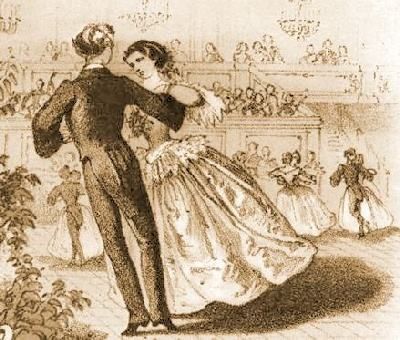
Image: Pinterest.
.
SHUN THE WALTZ
.
The waltz is a dance of quite too loose a character, and unmarried ladies should refrain from it altogether, both in public and private; very young married ladies, however, may be allowed to waltz in private balls, if it is very seldom, and with persons of their acquaintance. It is indispensable for them to acquit themselves with dignity and modesty. (1841; quoted from Gentleman and Lady’s Book of Politeness by Elisabeth Celnart)
.
…The round dance, waltz and tango are to be condemned on the same ground as spooning. (1916; quoted from Eugenics by T.W. Shannon)
.
.
Or, if you must waltz with all those people risking moral ruin, make sure you touch her waist in the least offensive manner.
.
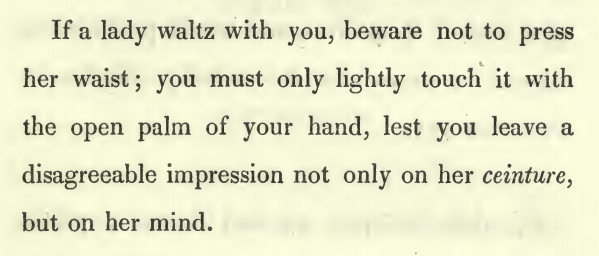
How to touch your dance partner’s waist while waltzing. From Hints on Etiquette and the Usages of Society with a Glance at Bad Habits by Charles Wm. Day, 1844.
.
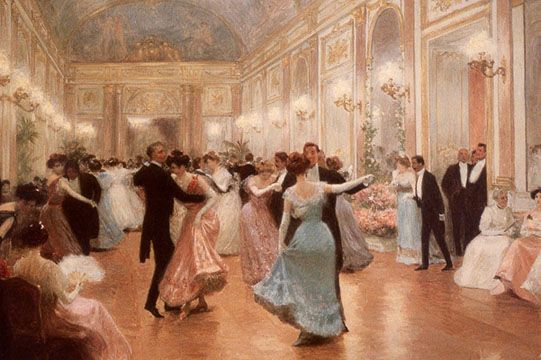
Image: Pinterest.
.

.
Decorum at the Dance
.
.
GENERAL RULES FOR A BALL-ROOM
.
A lady will not cross a ball-room unattended. A gentleman will not take a vacant seat next to a lady who is a stranger to him. If she is an acquaintance, he may do so with her permission. White kid gloves should be worn at a ball, and only be taken off at suppertime. In dancing quadrilles do not make any attempt to take steps. A quiet walk is all that is required. When a gentleman escorts a lady home from a ball, she should not invite him to enter the house; and even if she does so, he should by all means decline the invitation. he should call upon her during the next day or evening. (1881; quoted from Decorum: A Practical Treatise on Etiquette and Dress of the Best American by John A. Ruth)
.
.
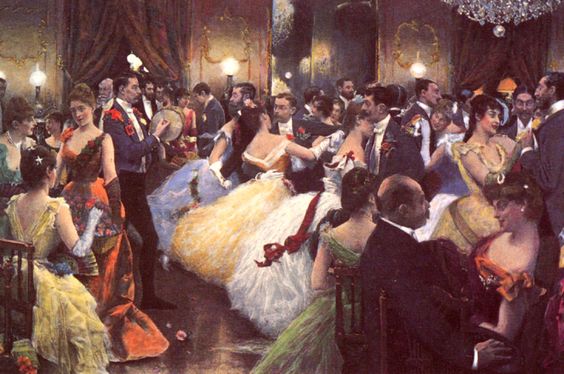
Julius LeBlanc Stewart, The Hunt Ball (1885), Essex Club, Newark, New Jersey. Includes portraits of the actress Lillie Langtry and Baron Rothschild. Image: Pinterest.
.
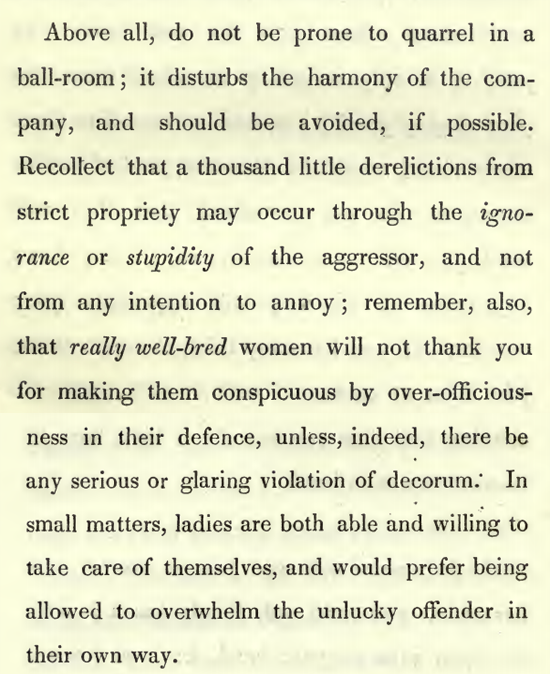
“Above all, do not be prone to quarrel in a ball-room,” and by all means, allow the ladies to manage unlikely offenders in their own way. From Hints on Etiquette and the Usages of Society with a Glance at Bad Habits by Charles Wm. Day, 1844.
.
A LADY AT A BALL
.
At a ball, the lady should always be accompanied by a gentleman; it is quite improper for her to saunter around alone. (1859; quoted from Beadle’s Dime Book of Etiquette by A Committee of Three)
.
.
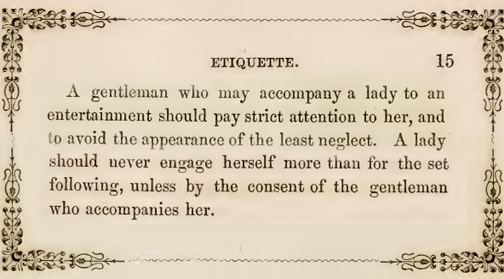
The Amateur’s Preceptor on Dancing and Etiquette by Prof. D. L. Carpenter of Philadelphia, 1854.
.
ONLY DANCERS
.
Only those who dance should accept invitations to a ball. The presence of “wall-flowers” is not an honorable distinction which a hostess will crave. (1892; quoted from Our Manners and Social Customs by Daphne Dale)
.
.

“Wall-Flower”, Image: How to Spend It
.
WALL-FLOWERS
.
The master of the house should see that all the ladies dance; he should take notice, particularly of those who seem to serve as draperies to the walls of the ball-room (or wall-flowers, as the familiar expression is,) and should see that they are invited to dance. (1881; quoted from Decorum: A Practical Treatise on Etiquette and Dress of the Best American by John A. Ruth)
.
.
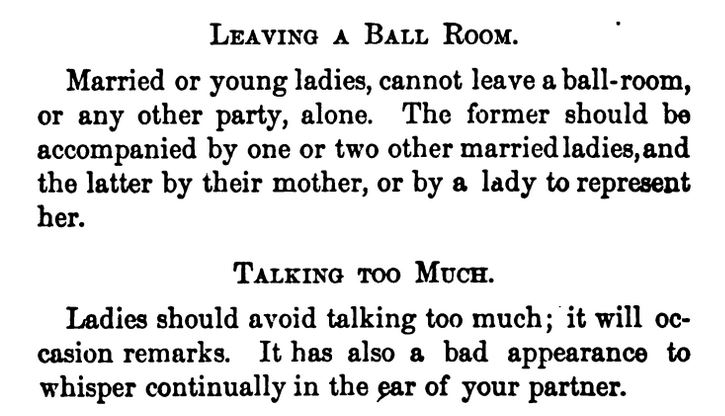
Ruth, John A.. Decorum: a Practical Treatise On Etiquette And Dress of the Best American Society. New York, [etc.]: Union Publishing House, 1881.
.
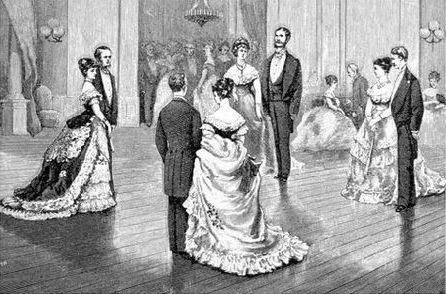
Image: Pinterest.
.

.
Victorian Dancing Etiquette, in Fiction
.
I enjoyed including tidbits of social expectations regarding balls and dancing in Sophia’s Leap-Year Courtship. The Leap-Year Ball was a big to-do in that book, and while not every element of decorum makes sense to today’s reader, several made for added fun–such as the gentlemen (with the role swap) being forbidden to walk across the ballroom, without escort.
.
In the second of my two-part blog post about Victorians and Leap-Year Traditions, I shared a vintage newspaper article (The Interior Journal, Stanford, Kentucky on March 30, 1888). quoting some of these specific etiquette details about ballrooms–and how they’re turned upside down for the enjoyment of Leap-Year. This newspaper article made it into Sophia’s Leap-Year Courtship, in its entirety.
.

.
Related Articles
.
.
Updated May 2021
Copyright © 2017 Kristin Holt LC
Victorian Dancing Etiquette Victorian Dancing Etiquette Victorian Dancing Etiquette

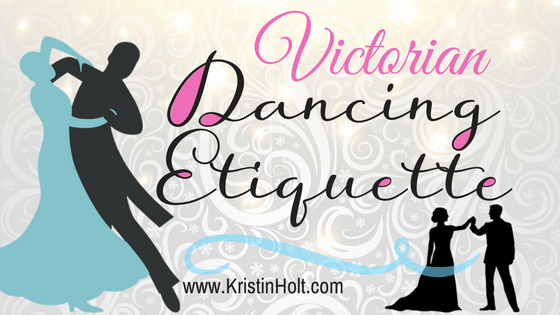









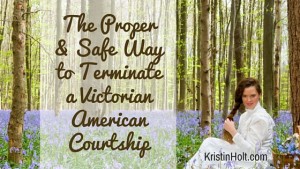
















With women being so outnumbered in the Old West, it was likely more than a little necessary to rely on enforcement of rules and manners to keep the peace during social events. That would help give the ladies time and a little less pressure to get to know the men vying for their hand. It also helped control the competition among the men.
Hi Patricia B.~
I agree with your insights and perspective. I can see you’ve thought about the “safety” that rules and decorum could bring to Old West events. Thanks so much for stopping by and contributing to the conversation.
Best,
Kristin